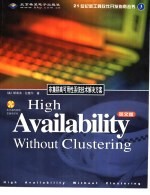
- 作 者:(美)斯蒂夫·拉塞尔著
- 出 版 社:北京:北京希望电子出版社
- 出版年份:2001
- ISBN:7900071733
- 标注页数:214 页
- PDF页数:223 页
请阅读订购服务说明与试读!
订购服务说明
1、本站所有的书默认都是PDF格式,该格式图书只能阅读和打印,不能再次编辑。
2、除分上下册或者多册的情况下,一般PDF页数一定要大于标注页数才建议下单购买。【本资源223 ≥214页】
图书下载及付费说明
1、所有的电子图书为PDF格式,支持电脑、手机、平板等各类电子设备阅读;可以任意拷贝文件到不同的阅读设备里进行阅读。
2、电子图书在提交订单后一般半小时内处理完成,最晚48小时内处理完成。(非工作日购买会延迟)
3、所有的电子图书都是原书直接扫描方式制作而成。
Contents 1
CHAPER 1 Introduction to availability 1
1.1 Availability 1
1.1.1 Clustering for high availability 2
1.1.2 High availability without clustering 3
1.2 Terminology 3
1.3 Improving availability 5
1.3.1 The cost of the alternative 5
1.3.2 Availability for xSeries and Netfinity servers 7
1.4 The scope of this book 13
CHAPTER 2 Tools for availability management 14
2.1 IBM Director 16
2.1.1 Advanced System Management 18
2.1.2 Setting up alerting 18
2.1.3 Capacity Manager 27
2.1.4 System Availability Tool 31
2.2 Universal Manageability Services(UMS) client 33
2.3 Other tools 35
2.3.1 Windows performance counters 35
2.3.2 Windows resource kits 36
2.3.3 Linux performance counters 37
CHAPTER 3 Integrated hardware availability features 40
3.1 Techniques to improve availability 41
3.2 Redundant power 42
3.3 Redundant cooling 44
3.4 Processors 46
3.5 Memory 46
3.5.1 Error checking and correcting memory(ECC) 47
3.5.2 Chipkill memory 48
3.6 Light Path Diagnostics 49
3.7 Advanced Systems Management hardware 52
3.7.1 Using a direct connection 53
3.7.2 Using an Ethernet connection 56
3.7.3 Automatic Server Restart 58
3.7.4 Remote Supervisor adapter 59
3.8 ActivePCI 63
3.8.1 Prerequisites for ActivePCI 63
3.8.2 Installing ActivePCI software for Windows 2000 64
3.8.3 Installing IBM Hot Plug for Windows NT 4.0 Package 67
CHAPTER 4 Disk subsystem availability 74
4.1 IBM xSeries and Netfinity server disk subsystems 75
4.2 ServeRAID controllers 76
4.2.1 ServeRAID controller families 76
4.3 Standard RAIDlevels 78
4.3.2 RAID-1 79
4.3.1 RAID-0 79
4.3.3 RAID-1E 80
4.3.4 RAID-5 81
4.3.5 RAID-5E 82
4.4 Advanced RAID levels 82
4.4.1 RAID-00 83
4.4.2 RAID-10 83
4.4.3 RAID-1E0 84
4.4.4 RAID-50 84
4.5 Servers with integrated RAID controllers 85
4.6 Choosing the right RAID Level 85
4.6.1 Important parameters 86
4.7 Failover RAID adapter pairs 86
4.7.1 Configuring a ServeRAID adapter failover pair 86
4.7.2 How failover adapter pairs work 87
4.8 FlashCopy 89
CHAPTER 5 Networking hardware for availability 94
5.1 Network adapters 95
5.2 Network adapter failover pairs 96
5.2.1 How to configure a failover adapter pair 96
CHAPTER 6 Keeping the operating system up and running 112
5.2.2 Failover adapter pairs in action 115
5.3 Load balancing 116
5.3.1 Types ofbalance 117
5.3.2 Where to deploy load balancing 117
5.3.3 Benefits of load balancing 118
5.3.4 Adapters that support load balancing 119
5.3.5 onfiguring load-balancing adapters 120
6.1 Windows NT 4.0 127
6.1.1 Hardware compatibility 128
6.1.2 Recovering from a blue screen 129
6.1.3 Automatically updating recovery information 130
6.1.4 Generating system documentation 131
6.1.5 Restarting failed services 132
6.1.6 Best practices 137
6.2 Windows 2000 137
6.2.1 Designed for reliability 138
6.2.2 Fewer reboots required 139
6.2.3 System file protection 139
6.2.4 Hardware compatibility 141
6.2.5 Recovering from a blue screen 145
6.2.6 Reducing recovery time 147
6.2.7 Restarting failed services 153
6.2.8 High availability storage 155
6.2.9 Application repair 156
6.2.10 Best practices 157
6.3 Linux 158
6.3.1 xSeries and Netfinity servers and Linux 159
6.3.2 IBM Director client for Linux 159
6.4 NetWare 162
6.4.1 The NetWare Management Portal 162
6.4.2 Portal functions 164
CHAPTER 7 Additional availability enhancements 172
7.1 Power 173
7.1.1 Uninterruptiblepower supplies 174
7.1.2 Power fault management software 174
7.1.3 Power conditioners 178
7.1.4 Independent power circuits 178
7.2.1 What it can do for you 179
7.2 Electronic Service Agent 179
7.2.2 Installation ofESA 181
7.2.3 Configuring and testing ESA 187
7.2.4 Enabling a system for ESA 191
7.2.5 Working with ESA 193
7.3 Update Connector Manager 198
7.3.1 Installation and configuration ofUCM 198
7.3.2 Discovering updates 201
7.3.3 Applying updates 203
7.4 The other 80210f availability 205
7.4.1 Planning and testing 205
7.4.2 Operations management 207
7.4.3 Training and support 208
7.4.4 Change management 209
7.4.5 BackuP 212
7.4.6 Disaster recovery 214
